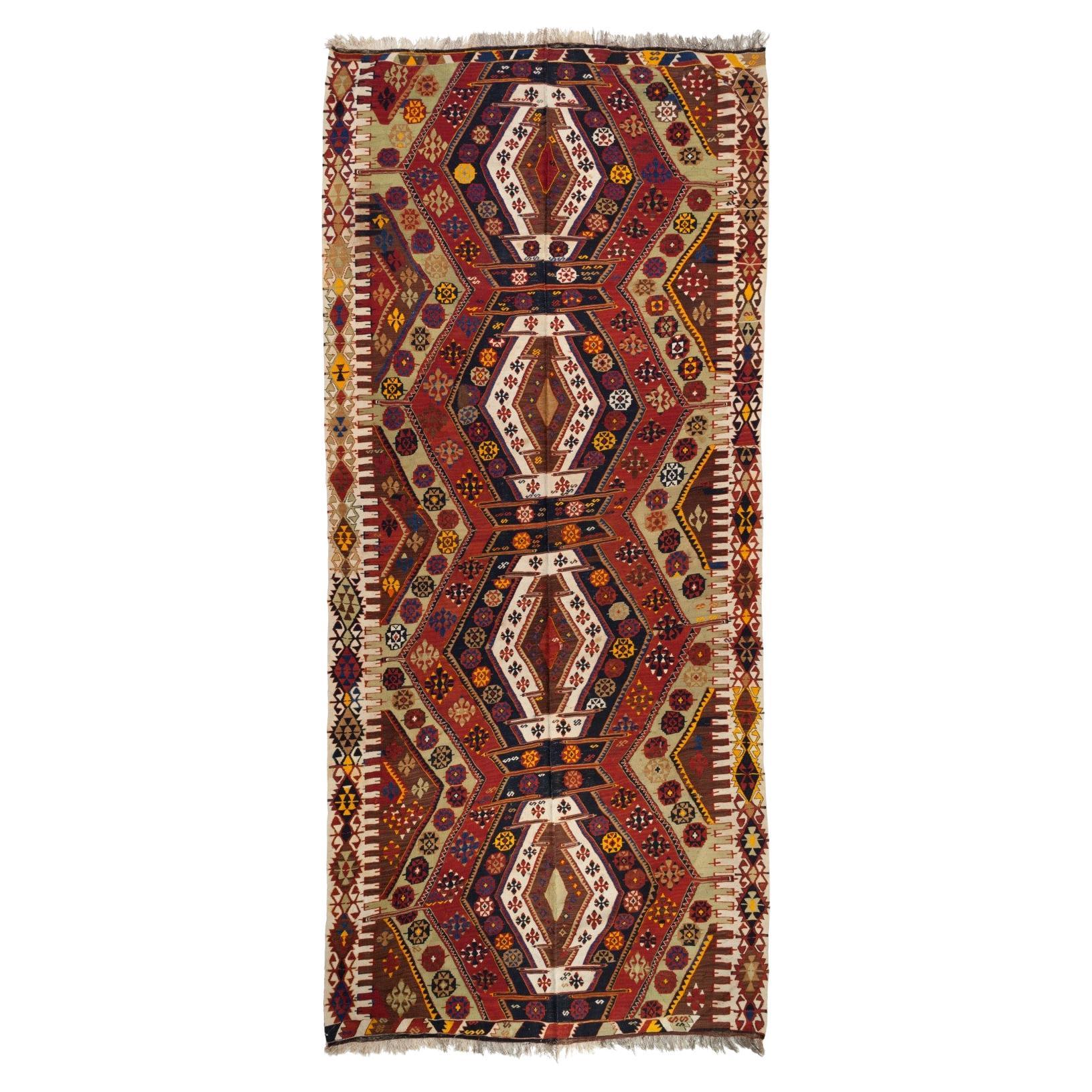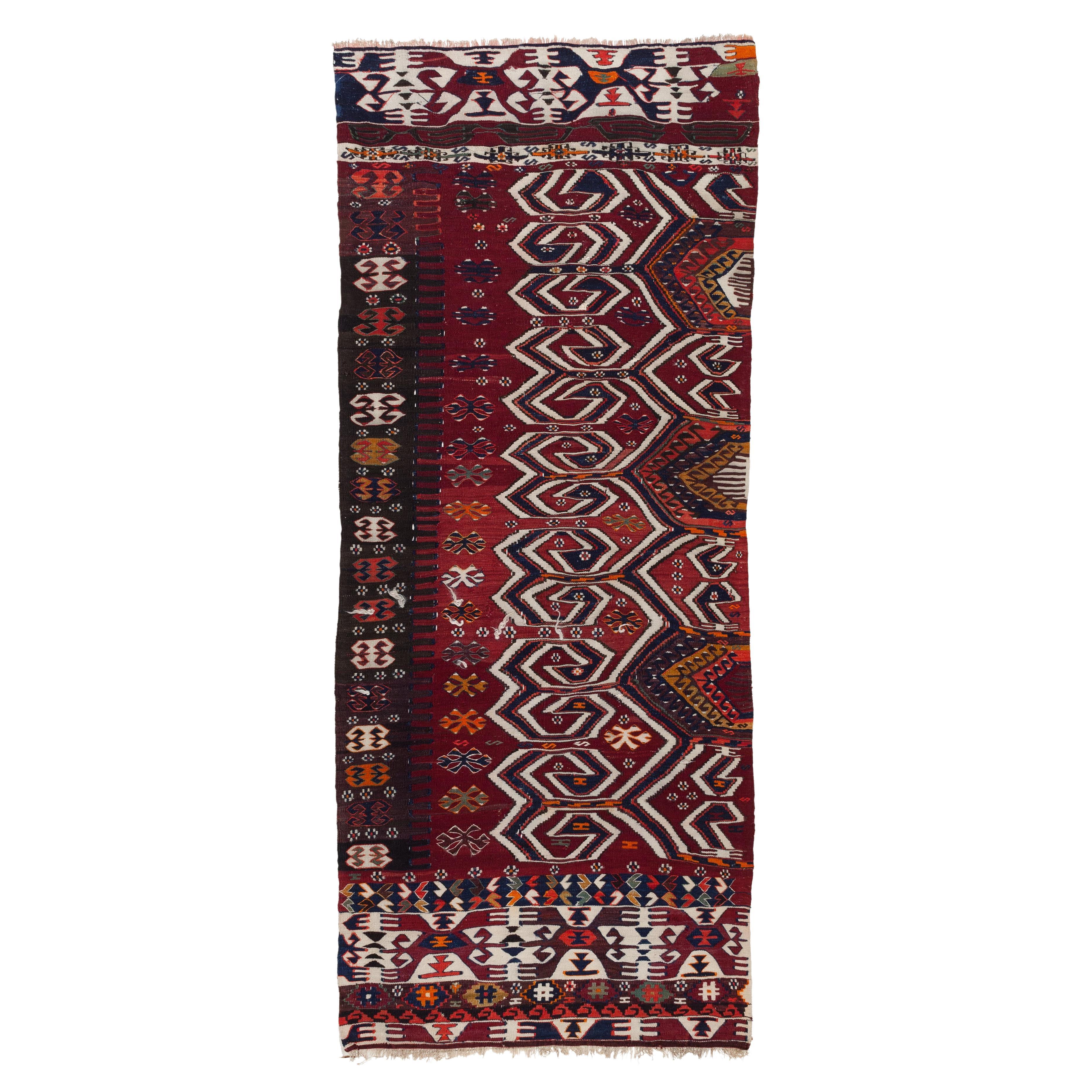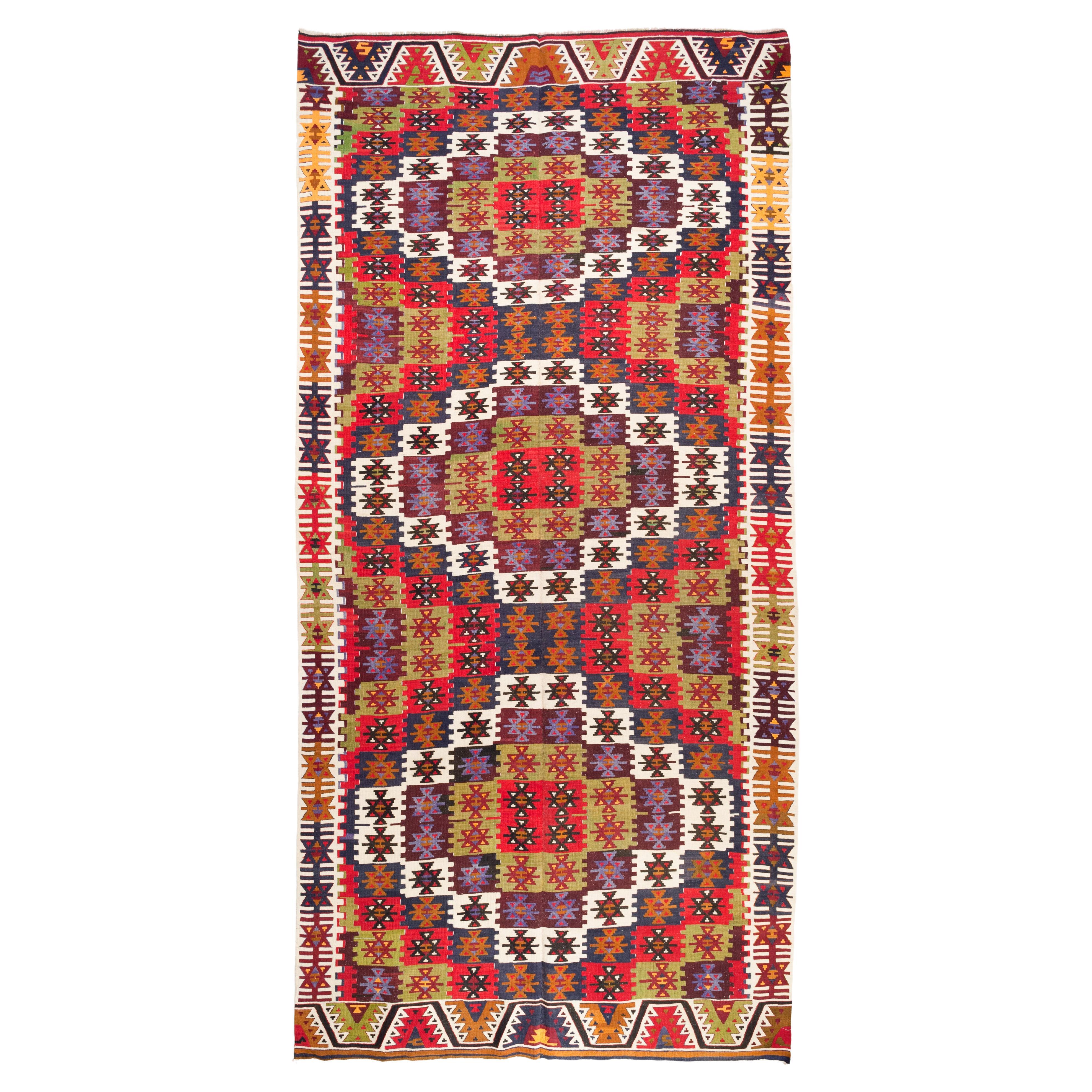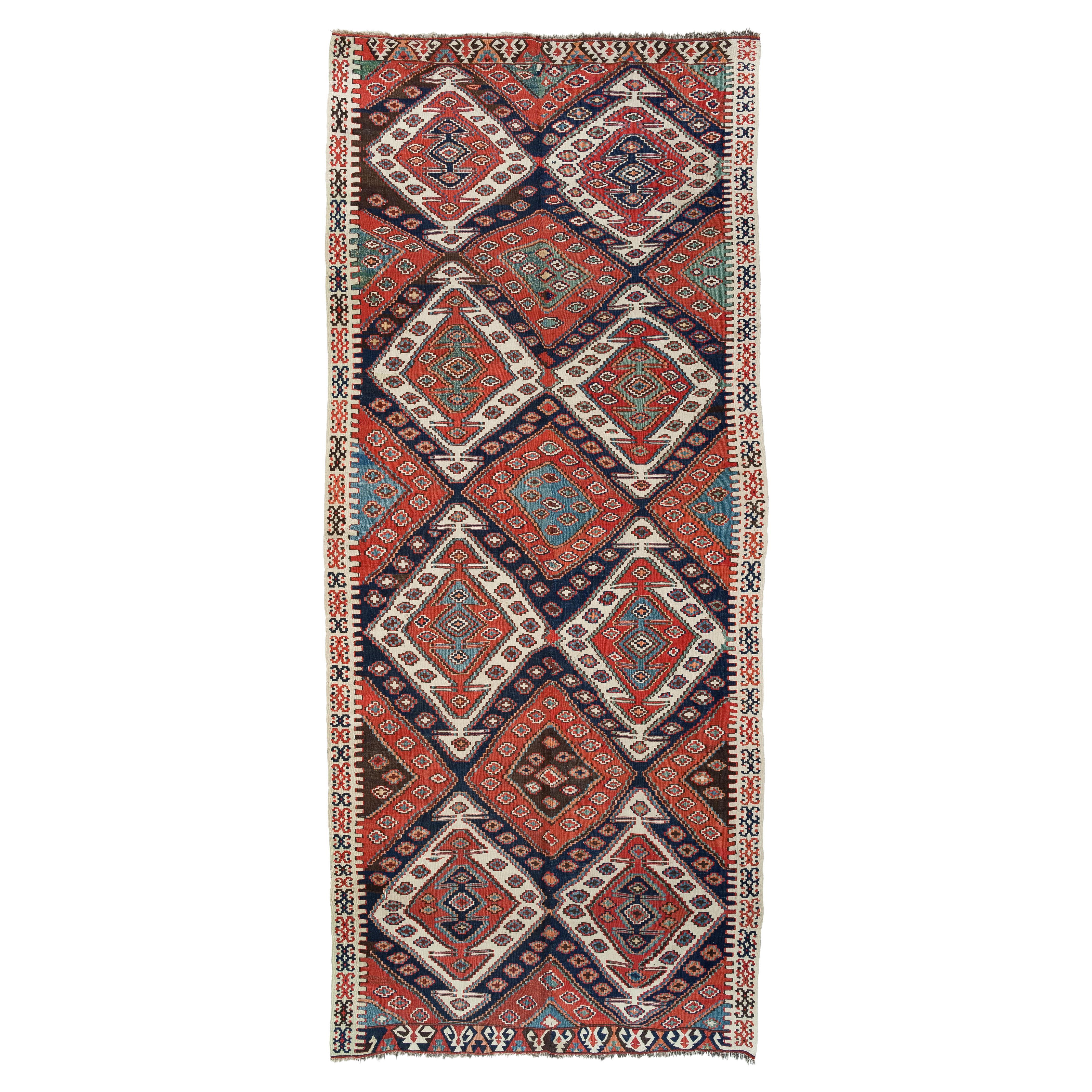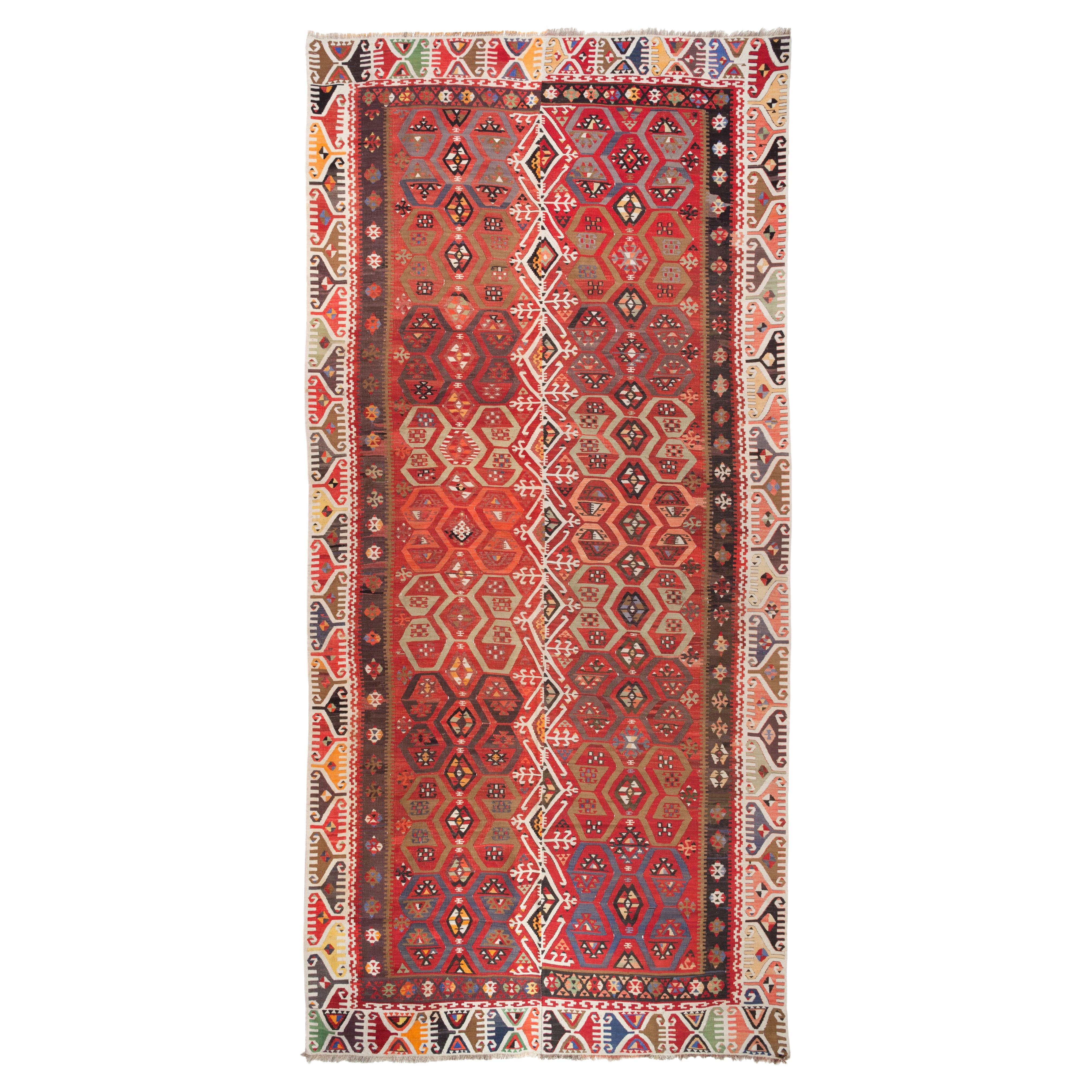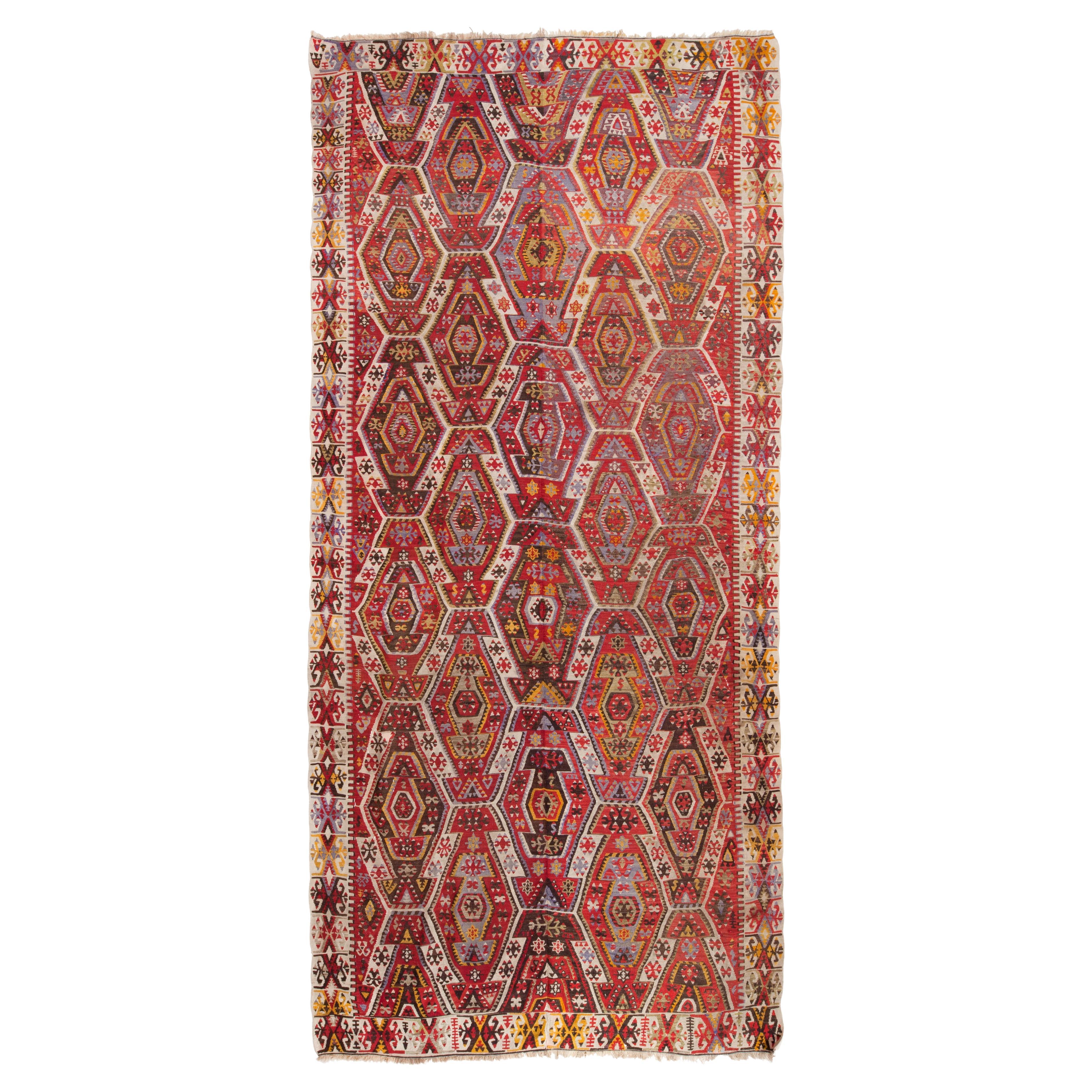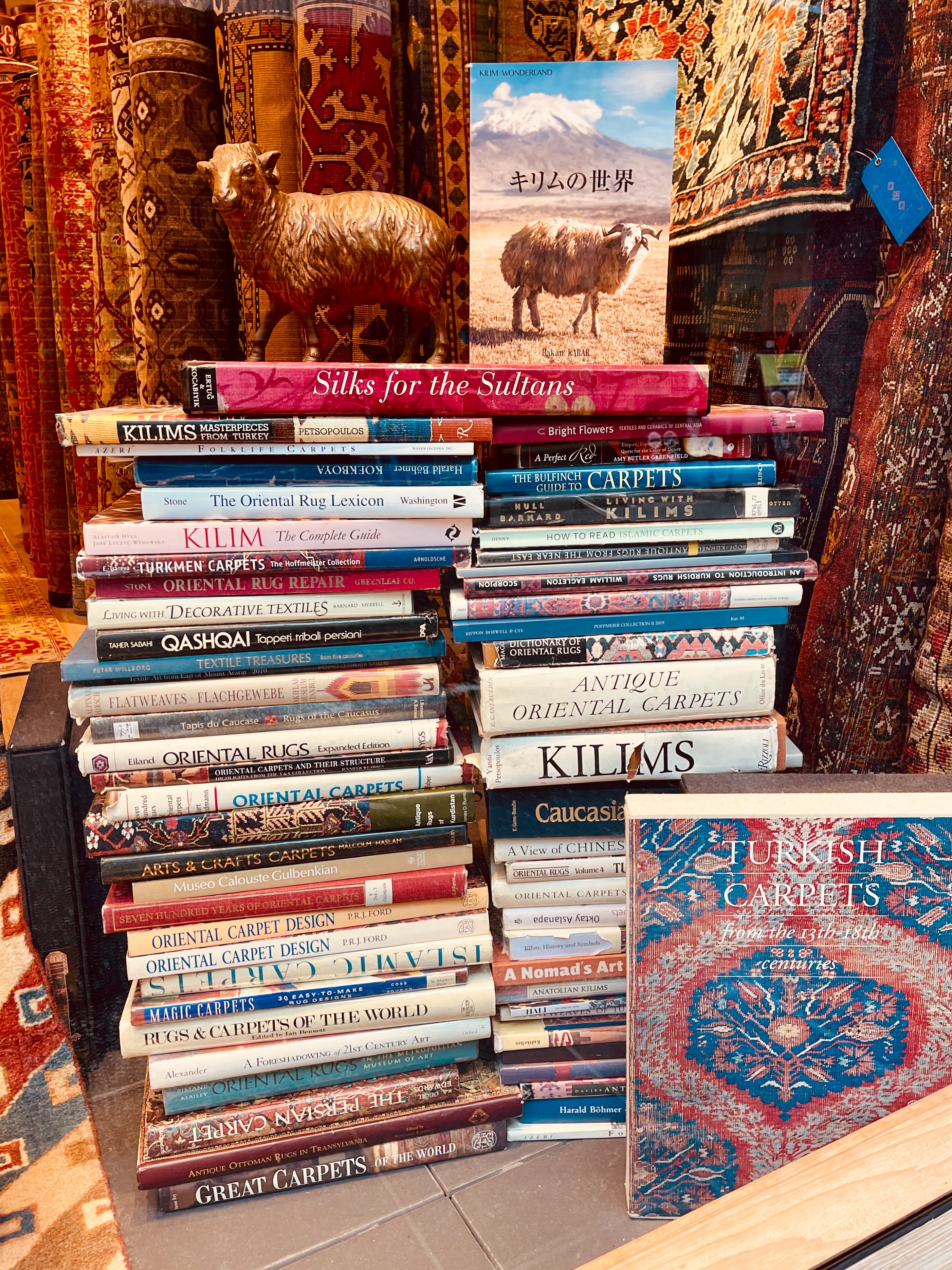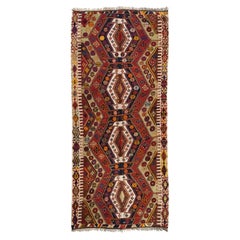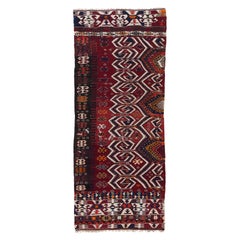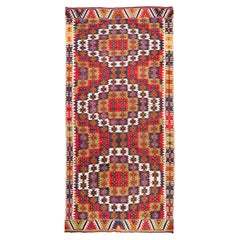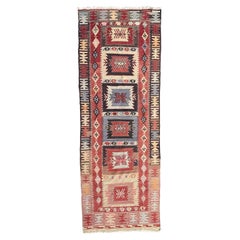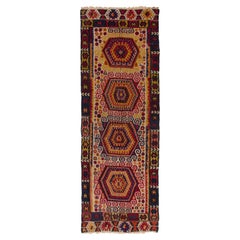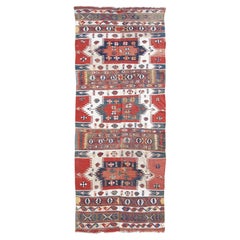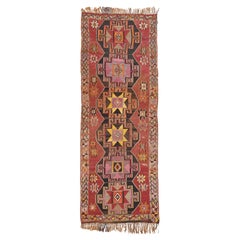Items Similar to Vintage Old Malatya Kilim South Anatolia Rug Turkish Carpet
Want more images or videos?
Request additional images or videos from the seller
1 of 10
Vintage Old Malatya Kilim South Anatolia Rug Turkish Carpet
$2,890
£2,220.28
€2,551.08
CA$4,065.14
A$4,567.01
CHF 2,386.27
MX$55,742.44
NOK 30,298.63
SEK 28,519.78
DKK 19,037.08
About the Item
This is a Southern Anatolian Vintage Kilim from the Malatya region with a rare and beautiful color composition.
It was originally a kilim with two halves, but this is one half. It is a colorful piece with a large medallion at its center. Encountering such a piece is precious. Half of them are somewhere else in the world, or they are the survivors of Kilims who might otherwise have disappeared from this world due to special damage that is difficult to repair. Kilim is such an organic existence. That's why you can enjoy the encounter with your piece a once-in-a-lifetime chance.
As you can see at a glance, each color is a very beautiful kilim. The beauty of the red of the field that was placed in the center by splitting it in half is eye-catching. The contrast between the navy blue, white, black, and yellow of the medallion and the pattern scattered on the field is vivid. A variety of other colors such as moss green, gray, and maroon are also woven in abundance. Many colors are finely woven together to give the impression of a brocade sash. The uneven dyeing of each color creates an expression that can be enjoyed like a painting. Also, the colors on the border that tighten all the colors are a modest presence, but I think it's very beautiful to change the expression.
Malatya is a town built on one main street that continues for several miles. It is situated in the Tohmasuyu River basin which is encircled by the high peaks of the eastern Taurus Mountains. This is a fertile agricultural region, particularly for apricots, and has been a prolific weaving area for many years. The modern town was established in 1838; old Malatya, which is close by, was once an important city in Armenia Minor. In Roman times it was important as a garrison town on the eastern frontier, and the settlement came under Ottoman rule in the early fifteenth century. Considering the number of kilims woven in this region there is a surprising lack of diversity in design, especially in the larger kilims; this is possibly a direct result of the Kurdish tribal tradition of weaving only one type of design. Small prayer rugs are more varied and often have great character and individuality. The quality of the kilims now woven in the region is deteriorating, and production for commercial purposes is slowly spreading into the villages. Large kilims generally feature three or four central medallions, while the smaller variety is usually decorated with one in the center. Some of these kilims have been referred to as 'Rashwan' weavings. The Rashwan was a Kurdish tribe that settled in parts of central and eastern Anatolia. These kilims are not easy to weave, for the designs are complicated and the filler motifs plentiful; indeed, their value has probably been underestimated by the market. Another variety of medallion kilim is also found in a smaller size and features a hexagonally shaped medallion with arms or hooks extending from the sides. This is used as a central motif arranged in a vertical line for smaller kilims, and for larger sizes, it is repeated in rows down the field. Such a motif is also found in Aksaray and Aleppo kilims, which have a lighter color palette. Banded kilims are borderless, and patterned with both narrow and wide alternating stripes. These are decorated with small motifs, often in supplementary weft-wrapping technique, and separated either by smaller patterned bands or by a plain color. Large sizes are made in two halves. As in other Kurdish weavings, a dark color palette of red, blue, brown, and some green is used that contrasts with undyed wool or bright white cotton. The wool is of good quality and lustrous, and sometimes very finely spun. Weaving techniques vary a great deal; some kilims incorporate both plain-weave and supplementary weft wrapping, although slitweave is predominantly used. The fringes of Malatya kilims are sometimes plaited. Many different sizes are found - large kilims, generally woven in two halves, small kilims, yastiks (cushions), and çuval (sacks).
- Dimensions:Width: 33.86 in (86 cm)Length: 149.61 in (380 cm)
- Style:Kilim (In the Style Of)
- Materials and Techniques:
- Place of Origin:
- Period:
- Date of Manufacture:circa 1950s
- Condition:Repaired: Minor repairs, with antique natural dyed wool threads by our repair specialists. Wear consistent with age and use. Minor fading.
- Seller Location:Tokyo, JP
- Reference Number:1stDibs: LU8206241300352
ARARAT RUGS
We know and believe that the geography we come from, our past, and our lifestyle are the most important bond between us to carry the oriental carpet art and culture to the next generations along with our core values in our ongoing growth journey.
We are aware that the way to achieve this goal and carry this priceless art and culture to the future depends on a lot of work with all our people every day while adhering to our core values.
For us, art is meaningful in the sense that it brings together various cultures around the world. It is an honor for us that oriental carpet art and culture have been instrumental in this for centuries and that we are a part of this business.
We are tirelessly keeping an eye on auction house information around the world about carpets. New York's Metropolitan, London's Victoria & Albert Museums, and other famous art museums, as well as small specialized museums that house private collections, and books about oriental carpets to collect information on outstanding carpet designs and patterns from around the world. It's our Self-improving and Self-developing culture.
As Turkish Culture of Hospitality, the Kurdish Culture of Generosity, and as Japanese Culture of Business Punctuality; are the most important values that this multicultural background has taught and bequeathed to us. It is essential and valuable for us that you feel this feeling not only by looking at our oriental carpets but from the moment you contact us.
About the Seller
5.0
Platinum Seller
Premium sellers with a 4.7+ rating and 24-hour response times
Established in 1970
1stDibs seller since 2023
55 sales on 1stDibs
Typical response time: 8 hours
- ShippingRetrieving quote...Shipping from: Tokyo, Japan
- Return Policy
Authenticity Guarantee
In the unlikely event there’s an issue with an item’s authenticity, contact us within 1 year for a full refund. DetailsMoney-Back Guarantee
If your item is not as described, is damaged in transit, or does not arrive, contact us within 7 days for a full refund. Details24-Hour Cancellation
You have a 24-hour grace period in which to reconsider your purchase, with no questions asked.Vetted Professional Sellers
Our world-class sellers must adhere to strict standards for service and quality, maintaining the integrity of our listings.Price-Match Guarantee
If you find that a seller listed the same item for a lower price elsewhere, we’ll match it.Trusted Global Delivery
Our best-in-class carrier network provides specialized shipping options worldwide, including custom delivery.More From This Seller
View AllMalatya Kilim Rug Wool Old Vintage Eastern Anatolian Turkish Carpet
Located in Tokyo, JP
This is Eastern Anatolian Old, Vintage Kilim from the Malatya region with a rare and beautiful color composition.
This highly collectible antique kilim has wonderful special colors ...
Category
Mid-20th Century Turkish Kilim Turkish Rugs
Materials
Wool, Natural Fiber
Antique Malatya Kilim South Anatolia Runner Rug, Turkish Natural Carpet
Located in Tokyo, JP
This is a Southern Anatolian Antique Kilim from the Malatya region with a rare and beautiful color composition.
It was originally a kilim with two halves, but this is one half. Encountering such a piece is precious. Half of them are somewhere else in the world, or they are the survivors of Kilims who might otherwise have disappeared from this world due to special damage that is difficult to repair. Kilim is such an organic existence. That's why you can enjoy the encounter with your piece a once-in-a-lifetime chance.
As you can see at a glance, each color is a very beautiful kilim. You can enjoy the goodness of ablush from the deep red to the bright color close to orange. Dark blue, orange, khaki, and white complement each other, making each color more vivid. What makes it unique is the beauty of khaki. Also, the dark brown on the border that tightens all the colors is a modest presence, but I think it's very beautiful to change the expression.
Malatya is a town built on one main street that continues for several miles. It is situated in the Tohmasuyu River basin which is encircled by the high peaks of the eastern Taurus Mountains. This is a fertile agricultural region, particularly for apricots, and has been a prolific weaving area for many years. The modern town was established in 1838; old Malatya, which is close by, was once an important city in Armenia Minor. In Roman times it was important as a garrison town on the eastern frontier, and the settlement came under Ottoman rule in the early fifteenth century. Considering the number of kilims woven in this region there is a surprising lack of diversity in design, especially in the larger kilims; this is possibly a direct result of the Kurdish tribal tradition of weaving only one type of design. Small prayer rugs...
Category
Early 20th Century Turkish Kilim Turkish Rugs
Materials
Wool, Natural Fiber
Old Adana Kilim Southern Anatolian Carpet Turkish Rug
Located in Tokyo, JP
This is a Southern Anatolian made in two halves of old Kilim from the Adana region with a rare and beautiful color composition.
Adana Situated in the fertile Çukurova plain (previ...
Category
Mid-20th Century Turkish Kilim Turkish Rugs
Materials
Wool, Natural Fiber
Antique Rashwan Malatya Kilim Anatolia Rug Turkish Carpet
Located in Tokyo, JP
This is a Southern Anatolian Antique Rashwan Kilim from the Malatya region with a rare and beautiful color composition.
It is a large, 4 meters long Kilim with two halves attached...
Category
Early 20th Century Turkish Kilim Turkish Rugs
Materials
Wool, Natural Fiber, Organic Material
Old Adana Kilim Southern Anatolian Carpet Turkish Rug Central Anatolian Style
Located in Tokyo, JP
This is a Southern Anatolian made in two halves of old Kilim from the Adana region. It has a rare and beautiful color composition, similar to central Anatolian motifs and design.
Ad...
Category
Mid-20th Century Turkish Kilim Turkish Rugs
Materials
Wool, Natural Fiber
Antique Malatya Kilim Rug Old South Eastern Anatolian Turkish Carpet
Located in Tokyo, JP
This is a South Eastern Anatolian antique Kilim from the Malatya region with a rare and beautiful color composition.
Malatya is Turkey's main kilim production area, and there are many variations. This is one of them, a runner-type kilim. The thread is thin, and the weave is very fine and dense. Some metallic threads are used in this antique kilim, which is rarely seen in Anatolian kilims. Red, navy blue, and gray are the colors that determine the impression of this kilim. Other colors, such as brown, yellow, and light blue, are also used in the patterns. The wavy horizontal striped pattern, plain pattern, and lined motif pattern are woven together to create a kilim that looks like an obi.
The pattern of the motif and the pattern of the wave are about the same amounts, giving a lively impression without getting busy. The deep shades of colors and patterns that are familiar to each other are unique to antiques. However, it still retains good coloring, which makes it hard to believe that it is an antique. The runner type is a good type to make this kilim unique. Also, for those who want to create a different kind of home, the use of runners is very effective.
Malatya is a town built on one main street that continues for several miles. It is situated in the Tohmasuyu River basin, which is encircled by the high peaks of the eastern Taurus Mountains. This is a fertile agricultural region, particularly for apricots, and has been a prolific weaving area for many years. The modern town was established in 1838; old Malatya, which is close by, was once an important city in Armenia Minor. In Roman times it was important as a garrison town on the eastern frontier, and the settlement came under Ottoman rule in the early fifteenth century. Considering the number of kilims woven in this region there is a surprising lack of diversity in design, especially in the larger kilims; this is possibly a direct result of the Kurdish tribal tradition of weaving only one type of design. Small prayer rugs...
Category
Early 20th Century Turkish Kilim Turkish Rugs
Materials
Wool, Natural Fiber
You May Also Like
Bobyrug’s Nice Vintage Anatolian Turkish Kilim
Located in Saint Ouen, FR
Very beautiful midcentury long Kilim, with a geometrical design and nice colors with red, blue, yellow, pink and purple, entirely handwoven with wool on cotton.
✨✨✨
"Experience the ...
Category
Mid-20th Century Turkish Kazak Turkish Rugs
Materials
Wool
$2,413 Sale Price
20% Off
5x14 Ft Antique Handmade Anatolian Konya Kilim, Flat-Weave Rug. Ca 1915
Located in Spring Valley, NY
An antique Turkish Kilim (flat-woven rug) with saturated plant dyed colors.
Very good original condition. It is finely handwoven and made of wool.
Measures: 5 x 14 Ft.
Category
Early 20th Century Turkish Kilim Turkish Rugs
Materials
Wool
$1,901 Sale Price
40% Off
Free Shipping
Antique Anatolian Karapinar Kilim, 19th Century
Located in San Francisco, CA
Antique Karapinar Kilim Rug, 19th Century
Additional Information:
Dimensions: 5'4" W x 13'0" L
Condition: Good
Origin: Anatolia (Turkey)
Period: 19th ...
Category
Antique 19th Century Turkish Turkish Rugs
Materials
Wool
Vintage Mid-Century Anatolian Gallery Size Kars Kilim Rug
Located in Milan, IT
A gallery-sized example of flat-woven wool kilim originating from Kars, located in eastern Anatolia close to the border with the Caucasus. The kilims from this region are renown for ...
Category
Mid-20th Century Turkish Kilim Turkish Rugs
Materials
Wool
Turkish Kilim Runner Malatya
Located in Alessandria, Piemonte
Also in this case the red background color has been softened and attenuated by the sun's rays.
The wools have been dyed with vegetable substances.
Put this cheerful runner at the en...
Category
Mid-20th Century Turkish Other Turkish Rugs
Materials
Wool
Antique Central Anatolian Kilim Rug
Located in New York, NY
Antique Central Anatolian Kilim rug. A great example of Anatolian Kilim rug weaving from the 19th century when tribal women wove such pieces as...
Category
Antique Late 19th Century Turkish Kilim Turkish Rugs
Materials
Wool
More Ways To Browse
Roman Medallion
Garrison Furniture Vintage
Cast Glass Coffee Table
Chairs Wicker Back
Cocktail Shakers
English Antique Mahogany Dining Room Tables
Marble Plinth Table
Marcel Breuer Black Chairs
Mdf Dining Table
Metal Console Green
Peach Glass
Porcelain Lady
Space Saving Furniture
Swedish Silver Stamps
Tropical Dining Table
Twisted End Table
Used Wood Bar Stools
Vintage Mohair Chair
